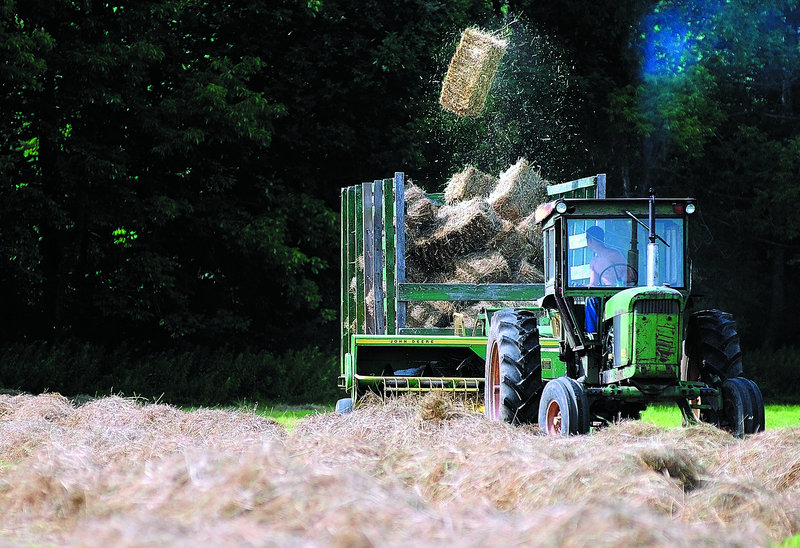“Perfect” summer weather has produced a bumper hay crop, giving dairy and cattle farmers a break in what it costs to feed their cows.
Dale Cole, a dairy farmer in Sidney, said his hay crop is better than he’s seen in the last few years.
Cole said this year the tonnage is decent and the quality is “pretty good.”
“You try to use more homegrown forages,” Cole said. “The better home-grown forages, the easier it is to balance your rations. You don’t have to bring in as much additional supplements, which are out-of-pocket expenses. It makes it easier in a tough financial year.”
Rick Kersbergen of the University of Maine Cooperative Extension in Waldo County said the volume of hay last year — when constant rain hampered harvesting — was substantial, but the quality was poor.
Farmers who were unable to cut hay in May because of the rain were forced to wait until July. then, the nutritional value of the hay — which Kersbergen says is better if the hay is cut in May — was compromised.
Consequently, cash-strapped dairy farmers had to supplement their cows’ diets with expensive grain.
Kersbergen said this year’s weather has been good for both hay and corn silage crops.
“We’re getting decent and sufficient rainfall to get second and third crops growing very well,” Kersbergen said. “You have to have a week or two at the end of May when it’s nice and dry to allow for a timely harvest — and we got decent weather in May. The middle was perfect.”
He said a hay farmer needs three or four days in a row without any rain for haying.
Sue Suchar, of Suchar Farms in China, grows hay with a neighbor who has a beef cattle operation. Suchar said she and her husband, Will Schultz, have the land; her neighbor, the equipment.
Suchar said they are about three-quarters done with haying. They grow a broome-orchard grass mix, which is very leafy and well cured.
“The nutritional value is much higher (in a timely cut), versus if your hay has gone by and there’s a lot of brown leaves,” Suchar said.
Suchar said her hay currently sells for $4 a bale, but in January, February and March, when they start advertising, their hay is sold for whatever the market is at that time.
Hay and grasses provide a good foundation and roughage for dairy cattle, according to Julie-Marie Bickford, executive director of the Maine Dairy Industry Association.
She said farmers can raise three crops of hay or grass in one season.
“Everybody I’m talking to is well on track of doing that and has started doing testing of the quality,” Bickford said. “The first crop has the highest quality of nutritional content and that’s what we’re coming up with. We’re getting some really high-quality first-crop haylage.”
She said an abundance of hay has no effect on what a dairy farmer receives for the sale of his milk. But it does affect what he has to pay out to feed his cows.
“If they don’t get a sufficient yield they have to buy more supplements,” she said. “If they don’t have to (supplement) as much, it decreases what it costs them to produce the milk. Where prices have not been very good, and the overall cost of production higher, it does help them close the gap of that break-even point.”
Send questions/comments to the editors.



Success. Please wait for the page to reload. If the page does not reload within 5 seconds, please refresh the page.
Enter your email and password to access comments.
Hi, to comment on stories you must . This profile is in addition to your subscription and website login.
Already have a commenting profile? .
Invalid username/password.
Please check your email to confirm and complete your registration.
Only subscribers are eligible to post comments. Please subscribe or login first for digital access. Here’s why.
Use the form below to reset your password. When you've submitted your account email, we will send an email with a reset code.